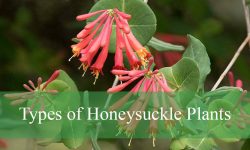Cypress trees are a diverse group of coniferous trees known for their distinctive beauty and adaptability to various environments. From the towering Bald cypress (Taxodium distichum) native to the wetlands of Florida to the exotic Bhutan cypress (Cupressus cashmeriana) with its weeping branches, each species offers unique characteristics that make them popular in both natural landscapes and ornamental gardens.
Gardeners and landscapers may choose the best cypress trees for their planting needs by being aware of the various varieties and their development, foliage, and environmental preferences.
Different Types of Cypress Trees
Bald cypress
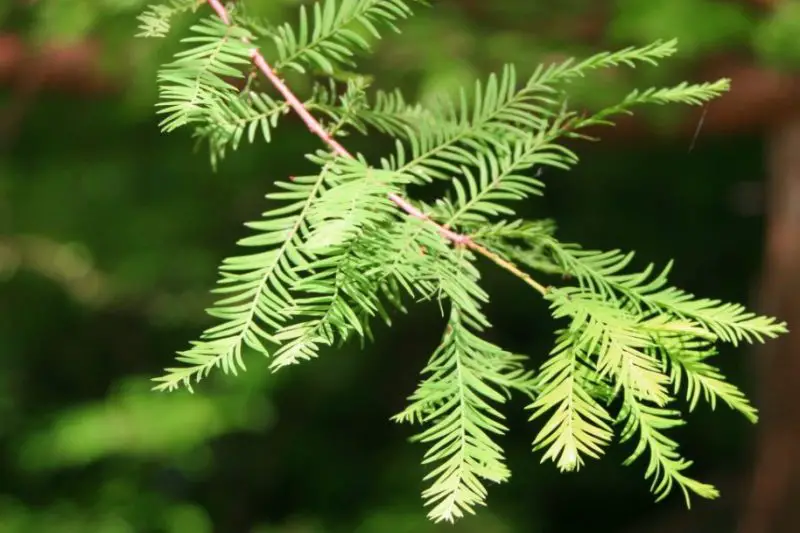
The Bald cypress (Taxodium distichum) is a remarkable tree native to Florida, perfectly adapted to thrive in wet environments such as ponds, marshlands, and flood zones. This adaptability, however, doesn’t limit its growth potential, as it can also tolerate drier soils, making it a versatile choice for various garden types.
The tree’s name derives from its unique characteristic of shedding its needles during winter, appearing “bald” in the colder months. Reaching impressive heights of up to 70 feet, the Bald cypress presents a distinct upright and triangular form, creating a striking silhouette in the landscape.
One of its most distinctive features is the unusual root structure, where roots wrap around protrusions called “knees” that emerge from the ground. These knees are particularly noticeable in wetter habitats and are believed to help with oxygenation.
When identifying a Bald cypress, look for its feathery, linear leaves arranged in two ranks along the branchlets, which turn a russet color before falling in autumn. The bark is reddish-brown, thin, and fibrous, becoming furrowed with age. In spring, small, round cones appear, maturing to about 1 inch in diameter by fall.
Bhutan cypress
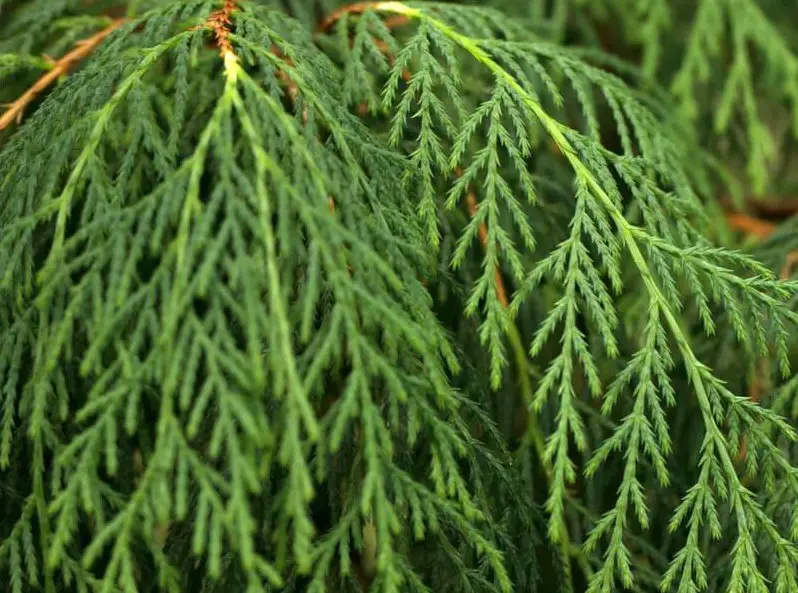
The Bhutan cypress (Cupressus cashmeriana) is a highly prized ornamental tree, renowned for its exquisite and graceful appearance. This cypress species stands out in landscapes due to its distinctive weeping branches and striking blue-green foliage, which create a cascading, almost ethereal effect.
Native to the Eastern Himalayas, particularly Bhutan, this tree adds an exotic touch to gardens and landscapes. The Bhutan cypress is often chosen as a focal point or specimen tree, perfectly complementing other plants such as yuccas, acacias, and palms. Its elegant form and unique coloration make it a standout in any garden design.
However, potential growers should be aware of its extensive growth habits and specific climate requirements. This cypress is only hardy in USDA Zone 9, limiting its cultivation to areas with mild winters.
The Bhutan cypress is distinguished by its weeping branches and blue-green, feathery foliage. Initially conical, it spreads with age. Its reddish-brown bark peels in strips, and it produces small, round cones. Known for its fast growth, reaching up to 30 meters, this cypress also features aromatic foliage when crushed. These characteristics make it a prized ornamental tree in suitable climates.
Californian cypress or Gowen cypress
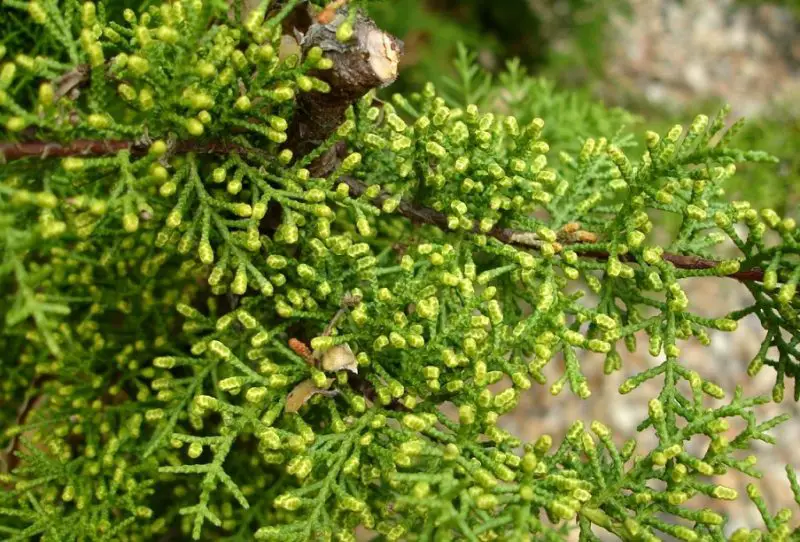
The Californian cypress, also known as Gowen cypress (Cupressus goveniana), is a remarkable evergreen native to California. This coniferous tree shares its origins with the Monterey cypress but possesses unique characteristics that set it apart. When well-maintained, it can reach impressive heights of up to 160 feet, showcasing a distinct conical form that adds architectural interest to landscapes.
The Gowen cypress is recognized by its dense foliage, composed of dark green to yellow-green needles that spray outwards, creating a lush, textured appearance. This spray-like arrangement of needles is a key identifying feature, giving the tree a fuller, more robust look compared to some other cypress varieties.
Its bark transitions from smooth reddish-brown to furrowed gray. Small, round cones and aromatic foliage are present. Branches grow horizontally or slightly upward. The tree’s slow growth rate contributes to its rarity, making it a prized specimen in botanical collections and specialized gardens.
Cheng’s cypress
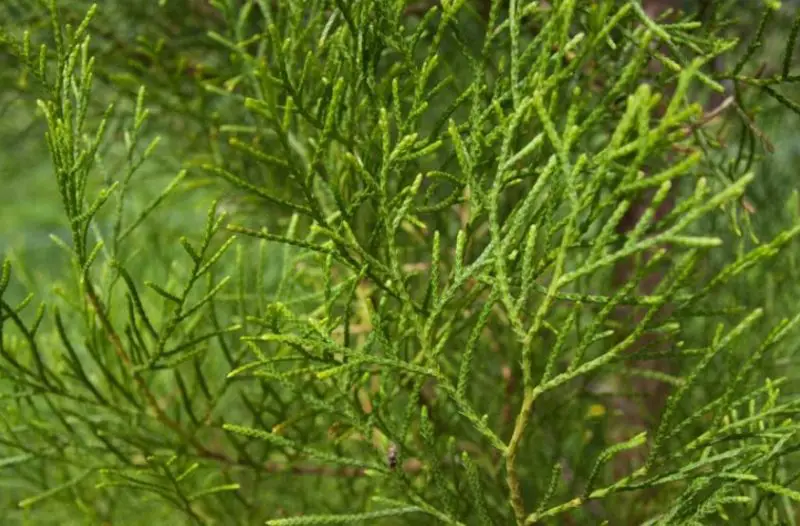
Cheng’s cypress (Cupressus chengiana) is an uncommon conifer native to China’s Gansu Province, where it thrives on hillsides and in valleys. This impressive tree can grow up to 100 feet tall, making it a prominent feature in its natural setting. Its attractiveness is heightened by its matte green leaves, which lend a soft, refined look. The tree also bears distinctive reddish-brown, spherical cones, adding to its decorative appeal.
Cheng’s cypress is recognized for its tall, upright stature, matte green foliage, and reddish-brown spherical cones. It features fissured bark and branches that spread horizontally, with scale-like leaves arranged in overlapping pairs. Growing at a slow to moderate pace, this rare species faces urgent conservation needs due to the threat of overlogging.
Chinese weeping cypress
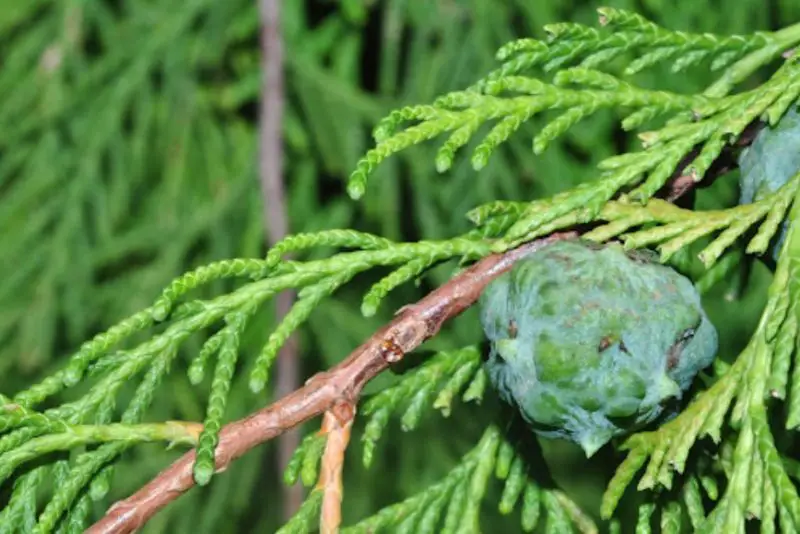
The Chinese weeping cypress (Cupressus funebris) is a striking ornamental tree prized for its unique aesthetic. Its most notable feature is the gracefully drooping branches that give it a distinctive weeping silhouette. This medium-sized conifer typically reaches heights of 30–50 feet, making it suitable for various landscape settings.
The tree’s foliage consists of light green, needle-like leaves that contribute to its delicate appearance. As it matures, the Chinese weeping cypress transitions from a conical shape to a more spreading form. The bark, initially smooth and reddish-brown, develops fissures with age, adding textural interest.
Characteristic small, round cones appear on the tree, usually measuring 1-2 cm in diameter. When crushed, the foliage releases an aromatic scent, enhancing its sensory appeal. This cypress species exhibits a slow to moderate growth rate, allowing for manageable development in cultivated environments.
Its combination of elegant form and attractive foliage makes the Chinese weeping cypress a popular choice for parks, gardens, and other landscapes where ornamental value is desired.
Cuyamaca cypress
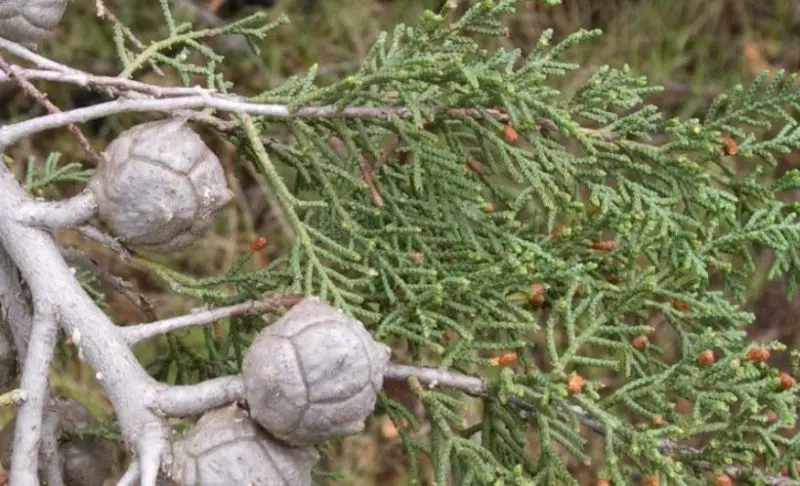
The Cuyamaca cypress (Cupressus stephensonii) is a remarkable conifer native to the rugged landscapes of San Diego, California. This unique tree species has adapted to thrive in the challenging terrain of its endemic region, reaching heights of up to 50 feet. The Cuyamaca cypress is distinguished by its open growth form, which creates an airy and less dense appearance compared to many other cypress varieties.
One of its most striking features is the smooth, reddish-brown bark that adds a warm, rich tone to its overall appearance. The foliage of the Cuyamaca cypress is particularly noteworthy, boasting a distinctive blue hue that sets it apart from its evergreen counterparts. This blue coloration not only enhances its visual appeal but also likely serves as an adaptation to its native environment.
Interestingly, the leaves of the Cuyamaca cypress possess aromatic properties, releasing a pleasant lemony scent when crushed. This olfactory characteristic adds another dimension to its unique identity. However, the species faces a critical threat to its existence. The devastating California wildfires of 2003 pushed the Cuyamaca cypress to the brink of extinction.
Hinoki cypress
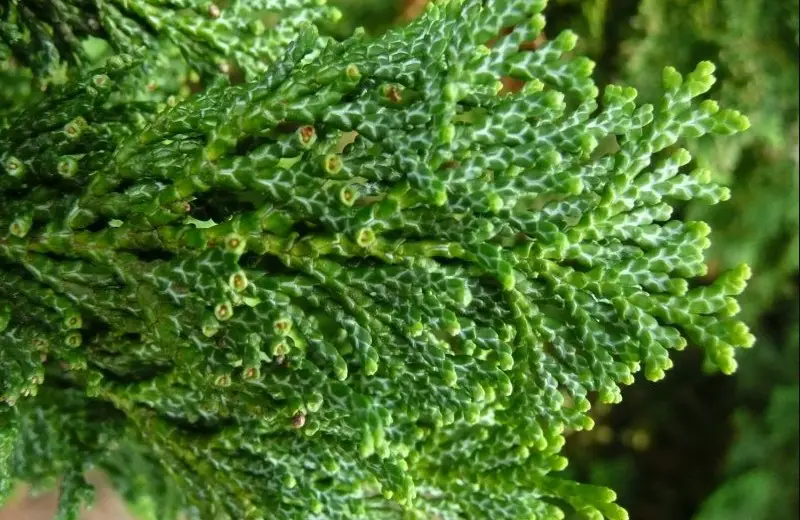
The Hinoki cypress (Chamaecyparis obtusa) is a revered conifer native to Japan, playing a significant role in Shinto religious practices. This slow-growing tree exemplifies the classic pyramidal shape associated with many cypress species. Its distinctive foliage is characterized by deep green, needle-like leaves with a glossy sheen, creating a lush and vibrant appearance. The branch tips exhibit a graceful drooping effect, adding to the tree’s elegant silhouette.
In its natural habitat, the Hinoki cypress can reach impressive heights of up to 80 feet, making it a commanding presence in the landscape. However, the species’ versatility is demonstrated by the existence of dwarf varieties, which have gained popularity as ornamental container plants. These smaller cultivars retain the attractive features of their larger counterparts but in a more compact form, making them suitable for gardens with limited space.
The cultural significance, combined with its aesthetic appeal and adaptability, has made the Hinoki cypress a prized specimen in both traditional Japanese gardens and contemporary landscapes worldwide.
Lawson cypress
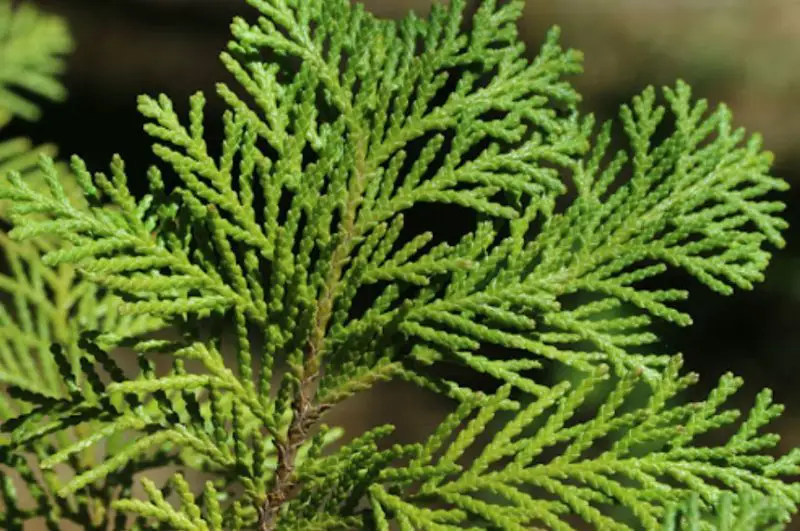
The Lawson cypress (Chamaecyparis lawsoniana), also known as Port Orford cedar, is a majestic evergreen conifer renowned for its impressive stature. This tree can reach extraordinary heights of up to 200 feet, making it a dominant feature in its native habitat and cultivated landscapes alike. Its foliage is characterized by distinctive blue-green leaf sprays and flat, scaly green leaves, creating a lush and textured appearance.
The Lawson cypress’s substantial size and dense growth habit make it an excellent choice for practical applications such as windbreaks, privacy screens, and natural property boundaries. Its ability to form a sturdy, living barrier has made it popular in both rural and urban settings.
Horticulturists have developed several notable cultivars of the Lawson cypress, each with unique characteristics. Among the most popular are:
1. Ellwoodii: Known for its compact, columnar form
2. Silver Thread: Prized for its silver-tinged foliage
3. Minima Glauca: A dwarf variety with a distinctive blue-green color
These cultivars offer landscapers and gardeners versatile options for different design needs and spatial requirements.
Lemon cypress trees
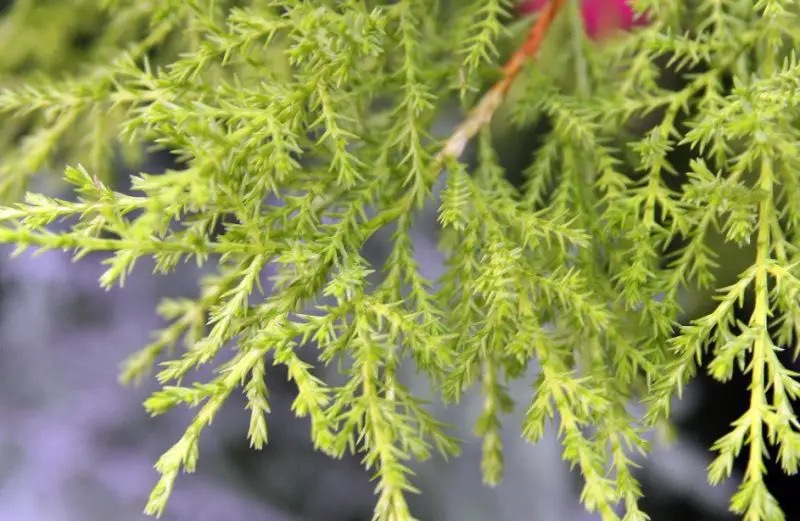
The Lemon cypress (Cupressus macrocarpa ‘Goldcrest’) is a highly sought-after ornamental tree, renowned for its striking appearance and versatility in landscaping. This cultivar stands out with its vibrant, golden-yellow foliage that maintains its color throughout the year, providing a constant burst of sunshine in gardens and outdoor spaces. The tree’s soft, feathery leaves contribute to its appealing texture and inviting appearance.
Characterized by its upright, columnar growth habit, the Lemon cypress presents a neat and compact form, making it suitable for various landscape designs. The tree’s bark has a distinctive scaly texture, adding visual interest to its overall appearance. Small, spherical cones appear on mature trees, further enhancing their ornamental value.
The Lemon cypress’s unique combination of golden foliage, elegant form, and low maintenance requirements has made it a favorite among gardeners and landscape designers for both residential and commercial applications.
Leyland cypress tree
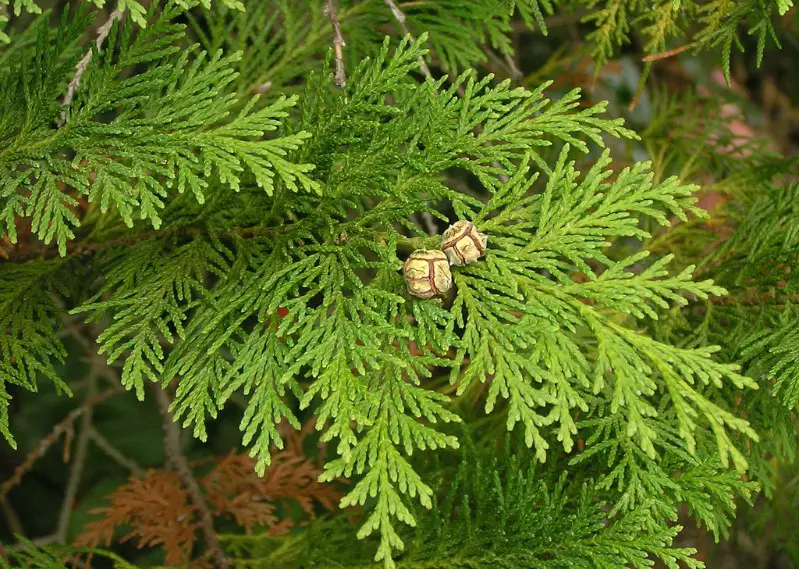
The Leyland cypress (Cupressus x leylandii) is a remarkable hybrid, born from the crossing of Nootka cypress and Cupressus macrocarpa. This conifer is celebrated for its distinctive narrow, symmetrical form, often described as having a “palace charm.” Its appearance is particularly striking during spring, when its foliage exhibits extra vibrancy, and in fall, when it transforms into a stunning golden yellow.
The tree’s elegant silhouette and rapid growth rate have made it a popular choice for various landscaping applications. In the United States, it’s frequently used as a focal point in expansive estates, where its towering presence can be fully appreciated. Across the Atlantic, the Leyland cypress has gained immense popularity in the United Kingdom as a hedge plant, prized for its ability to create dense, uniform privacy screens.
This versatile cypress adapts well to different environments and serves multiple purposes in landscape design, from ornamental specimen to functional barrier, showcasing its adaptability and aesthetic appeal.
Macnab cypress
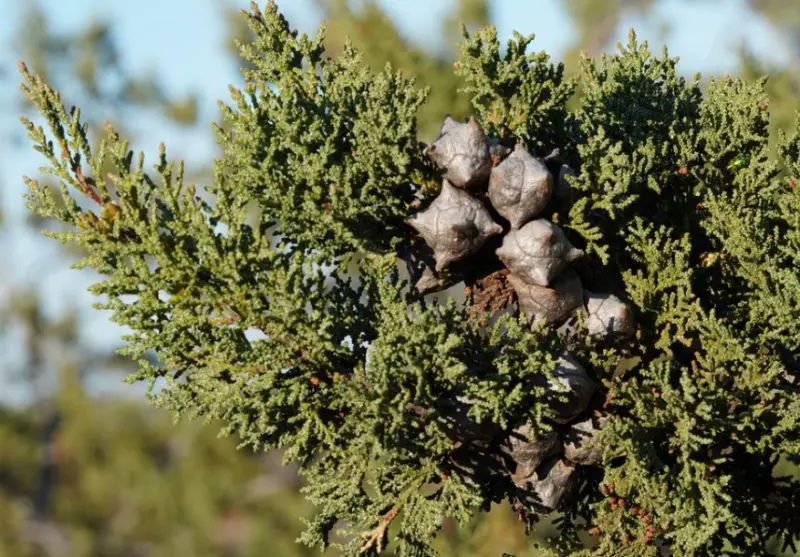
The Macnab cypress (Cupressus macnabiana) is a distinctive conifer native to northern California, characterized by its unique features and compact growth habit. This species stands out with its tiny, oblong cones and light green foliage, arranged in delicate sprays. A particularly intriguing aspect of the Macnab cypress is the presence of horn-like projections on its scaly surface, adding textural interest to its overall appearance.
Despite its relatively modest size, typically reaching heights of up to 40 feet, the Macnab cypress boasts highly ornamental qualities. Its foliage exhibits a subtle purple sheen, creating an eye-catching contrast against other garden plants. The tree’s bark is equally striking, displaying a rich, reddish-brown color that enhances its visual appeal.
Unlike many of its taller cypress relatives, the Macnab cypress often grows more as a large shrub or small tree, making it suitable for smaller landscapes or as a focal point in garden designs where space may be limited.
Mediterranean cypress or Italian cypress
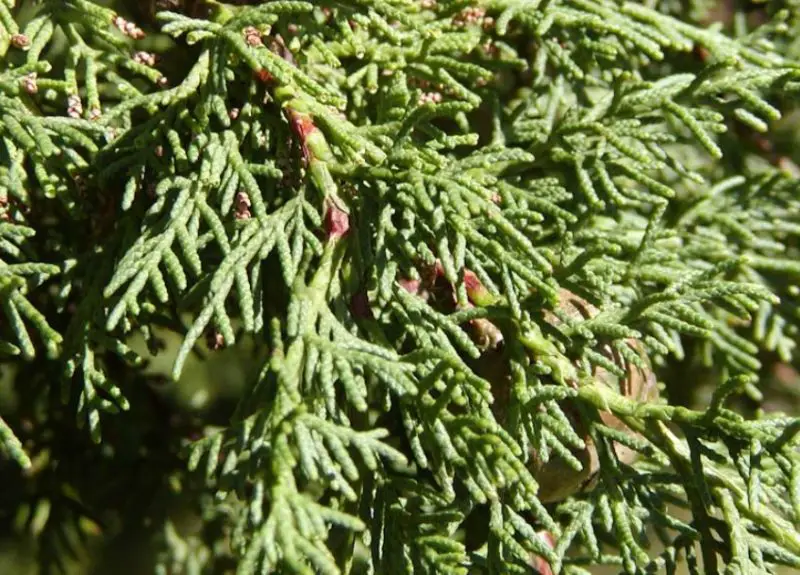
The Mediterranean cypress, also known as Italian cypress (Cupressus sempervirens), is often regarded as the quintessential cypress species. This iconic tree is characterized by its impressive height and distinctive narrow, columnar shape, which has made it a staple in classical landscapes and formal gardens. The foliage is arranged in dense, feathery bands of deep green, featuring scaly leaves that contribute to its rich, textured appearance.
Unlike many other cypress species, the Mediterranean cypress produces elongated seed cones, adding to its unique profile. These trees can reach towering heights of up to 70 feet, creating dramatic vertical elements in the landscape. Their striking silhouette and cultural significance have made them a frequent subject in literature and biblical texts, cementing their place in both horticultural and historical contexts.
The Mediterranean cypress’s enduring popularity stems from its elegant form, low maintenance requirements, and ability to thrive in various Mediterranean-like climates around the world.
Mendocino cypress
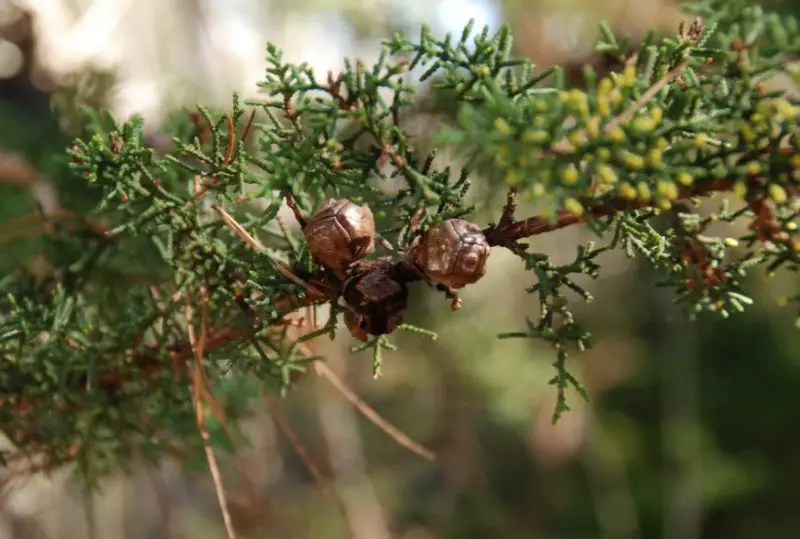
The Mendocino cypress (Cupressus pygmaea), also known as pygmy cypress, is a distinctive conifer native to California’s coastal regions. Often considered a subtype of Cupressus goveniana, this unique tree has carved out its own identity in both botanical and ornamental contexts.
What makes the Mendocino cypress particularly appealing to horticulturists and gardeners are its long, scaly leaves that showcase a rich, dark green color. This foliage creates a dense, textured appearance that adds depth and interest to landscapes. Adding to its ornamental value are its distinctive cones, which set it apart from other cypress species. These cones are rounded in shape, with scales arranged in an opposite pattern, creating an intriguing visual element.
Despite its “pygmy” moniker, the Mendocino cypress can vary significantly in size depending on its growing conditions, ranging from shrub-like forms to more substantial trees. This adaptability, combined with its unique aesthetic qualities, makes it a prized specimen for coastal gardens and beyond.
Monterey cypress
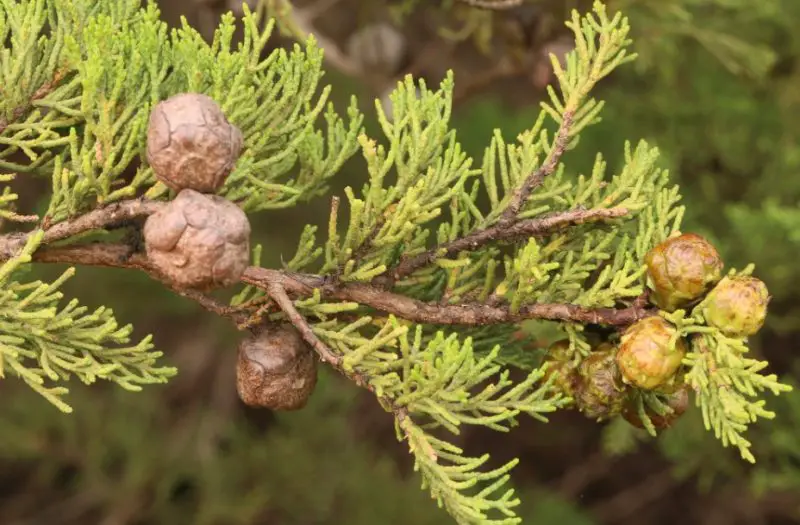
The Monterey cypress (Cupressus macrocarpa) is a distinctive medium-sized conifer native to California, renowned for its unique flat-topped silhouette and laterally spreading branches. This tree can reach impressive heights of up to 130 feet, creating a commanding presence in its natural habitat and cultivated landscapes.
One of the Monterey cypress’s most notable features is its foliage, consisting of soft, scaly leaves in a vivid, bright green color. When crushed, these leaves release a strong citrus aroma, adding a sensory dimension to the tree’s appeal. The tree is further distinguished by its woody, oblong cones, which contrast with the more common spherical cones of many other cypress species.
The Monterey cypress also boasts fibrous bark, contributing to its textural interest. This combination of unique form, aromatic foliage, distinctive cones, and interesting bark texture makes the Monterey cypress a prized specimen for both its ornamental value and its significance in its native ecosystems.
Moroccan cypress
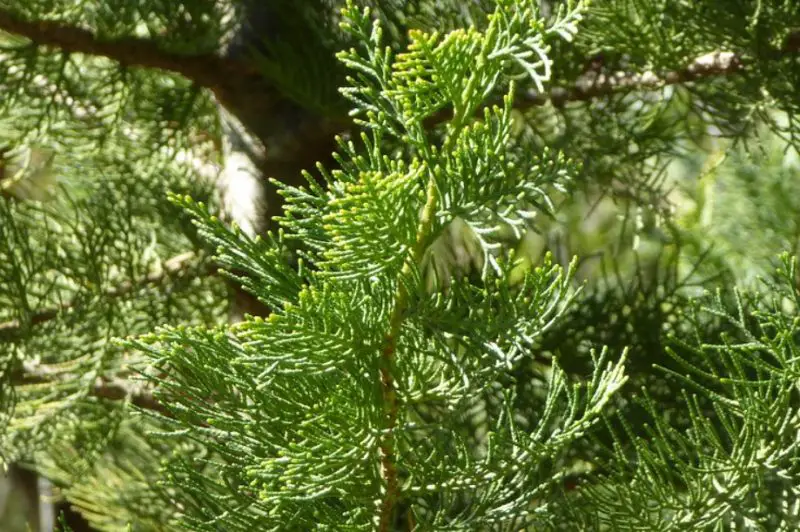
The Moroccan cypress (Cupressus atlantica), also known as Atlas cypress, is a remarkable conifer native to the Atlas Mountains of Southern Morocco. This impressive tree can reach heights of up to 100 feet, making it a commanding presence in its natural habitat. The Moroccan cypress is distinguished by its striking blue foliage adorned with white streaks, creating a unique and attractive appearance. Its trunk is equally noteworthy, featuring a distinctive gray color with a cracked texture that adds to its visual appeal.
This species is well-adapted to harsh conditions, demonstrating impressive resistance to both drought and freezing temperatures. The wood of the Moroccan cypress is highly valued for its durability, light weight, and aromatic properties, making it desirable for various applications. However, these valuable characteristics have led to overexploitation, compounded by overgrazing in its native range. As a result, conservation efforts have been implemented, including bans on logging, to protect this unique and important species from further decline.
Nootka cypress
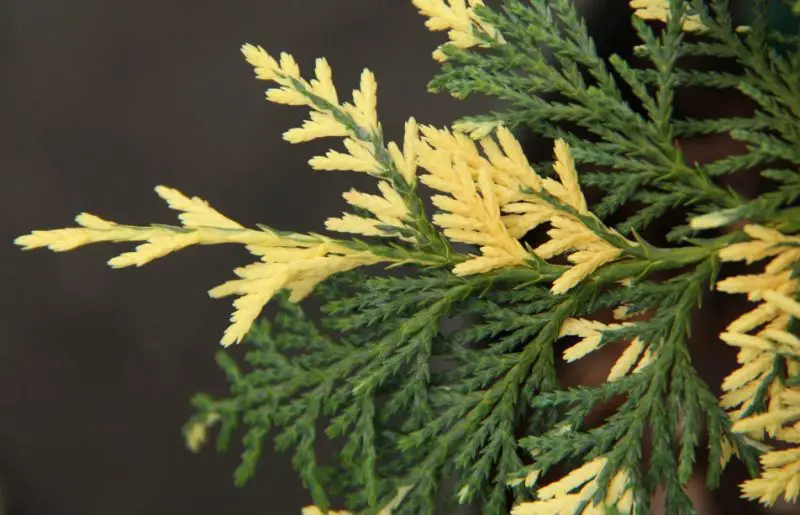
The Nootka cypress (Cupressus nootkatensis ‘Green Arrow’), also known as Alaskan cypress, is a resilient conifer native to the Pacific Northwest, ranging from Alaska to northern California. This cultivar is particularly well-suited for cold climates and winter gardens, thriving in conditions that would challenge many other tree species. The ‘Green Arrow’ variety is characterized by its distinctively narrow frame, which creates a striking vertical accent in landscapes.
The tree’s foliage is composed of rich, deep green needle-like leaves, providing year-round color and texture. Typically growing to heights of up to 20 feet with a modest spread of around 4 feet, the Nootka cypress ‘Green Arrow’ maintains a compact, columnar form that makes it ideal for smaller gardens or as a focal point in larger landscapes.
Its ability to withstand freezing temperatures, combined with its attractive form and evergreen foliage, makes the Nootka cypress ‘Green Arrow’ a valuable addition to gardens in colder regions, offering both aesthetic appeal and hardiness.
Pond cypress
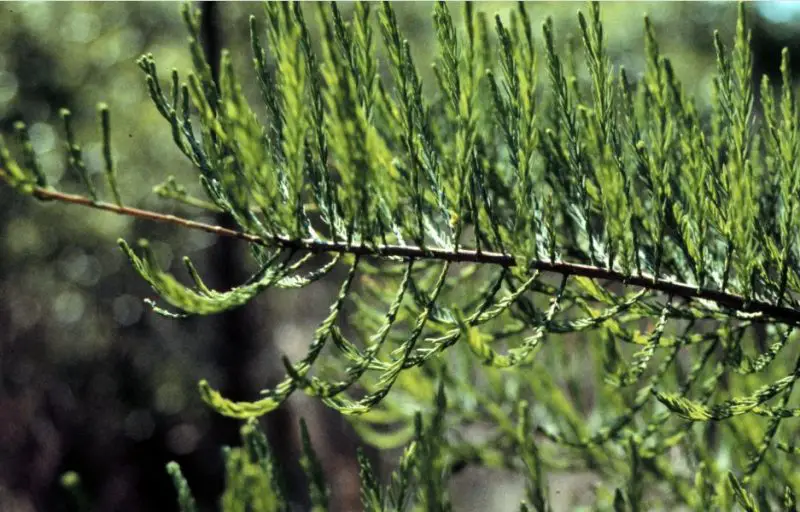
The Pond cypress (Taxodium ascendens) is a distinctive Florida native tree, closely related to but distinct from its more famous cousin, the bald cypress. This species is characterized by its narrower, more columnar form, reaching heights of up to 60 feet. One of its most striking features is its seasonal color change, with foliage turning a beautiful golden brown and orange during autumn, creating a spectacular display.
When grown near water bodies such as marshes and ponds, the Pond cypress exhibits a unique adaptation: its trunk appears swollen at the base, an interesting visual characteristic. Unlike the bald cypress, however, it does not produce “knees,” the distinctive root structures often associated with cypress trees in wetlands.
Interestingly, despite its affinity for wet environments, the Pond cypress demonstrates remarkable drought tolerance, making it a versatile choice for various landscape settings. This combination of adaptability, attractive form, and seasonal interest makes the Pond cypress a valuable species for both natural and cultivated landscapes.
Saharan cypress
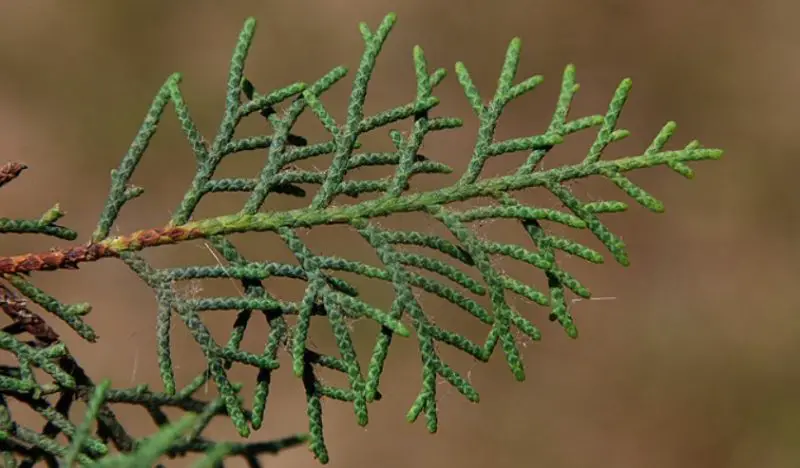
The Saharan cypress (Cupressus dupreziana) is a remarkable conifer endemic to the harsh environment of the Sahara region. This species stands out as the most drought-resistant among Saharan cypresses, a testament to its exceptional adaptation to extreme arid conditions. Despite its challenging habitat, the Saharan cypress can reach impressive heights of up to 100 feet, featuring matte green foliage that contributes to its distinctive appearance.
Demonstrating remarkable resilience, this cypress can tolerate winter temperatures as low as 7°C, showcasing its adaptability to temperature fluctuations characteristic of desert climates. However, the Saharan cypress faces a critical threat to its existence. With only approximately 150 mature trees remaining in the wild, it is classified as near extinct, highlighting the urgent need for conservation efforts.
The unique adaptations and extreme rarity of the Saharan cypress make it a subject of great interest for botanists and conservationists alike, emphasizing the importance of preserving this extraordinary species for future generations.
San Pedro Martir cypress
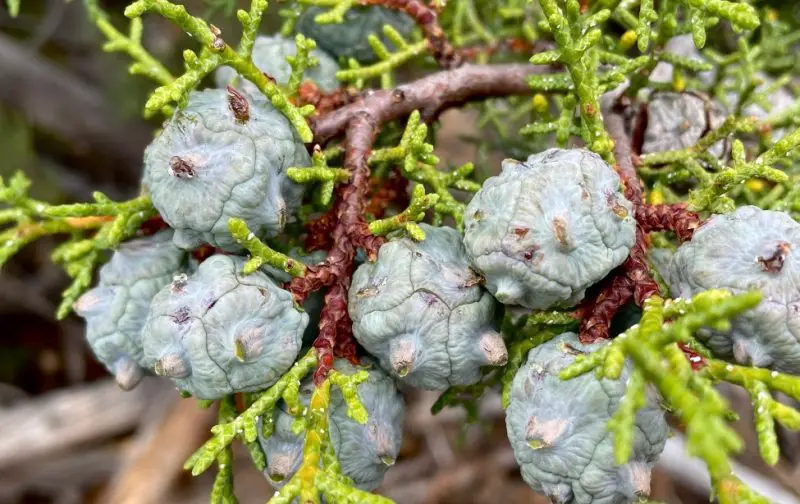
The San Pedro Martir cypress (Cupressus Montana) is a distinctive conifer native to Mexico and California, typically reaching heights between 16 and 65 feet. It’s characterized by its conical yet open growth form, creating an interesting silhouette in its native habitats. The tree’s dark brown bark, which strips as it ages, adds to its visual appeal and helps distinguish it from other cypress species.
Notably, the San Pedro Martir cypress bears a striking resemblance to the Arizona cypress, often leading to comparisons between the two species. This similarity highlights the close relationships within the cypress family and the adaptations shared by trees growing in similar climatic conditions.
Smooth Arizona cypress
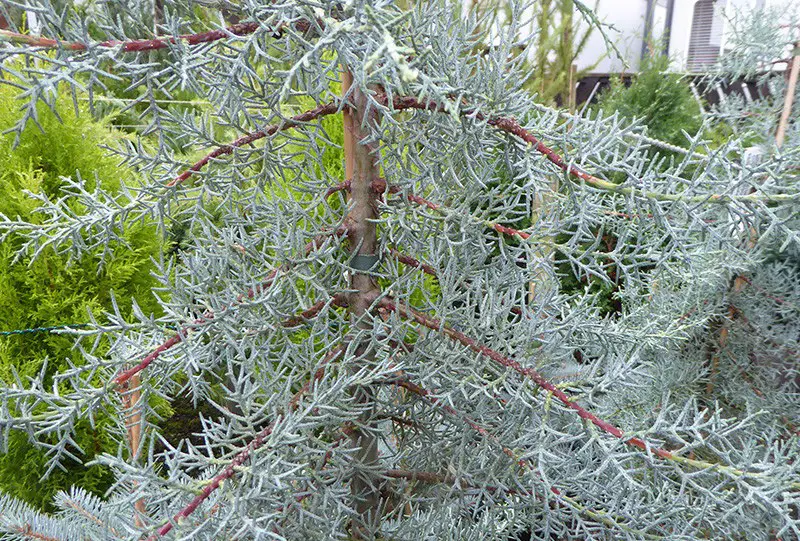
The Smooth Arizona cypress ‘Blue Ice’ (Cupressus arizonica var. glabra ‘Blue Ice’) is an exceptional choice for gardeners seeking a hardy cypress suitable for up to USDA Zone 6. This variety thrives in dry environments with cool nights, making it adaptable to various challenging conditions.
The ‘Blue Ice’ cultivar is particularly noteworthy for its striking open form, which creates an attractive silhouette in the landscape. Its standout feature is the stunning foliage, composed of silver and blue-green needles that provide year-round interest and a unique color palette for garden designs.
Tecate cypress
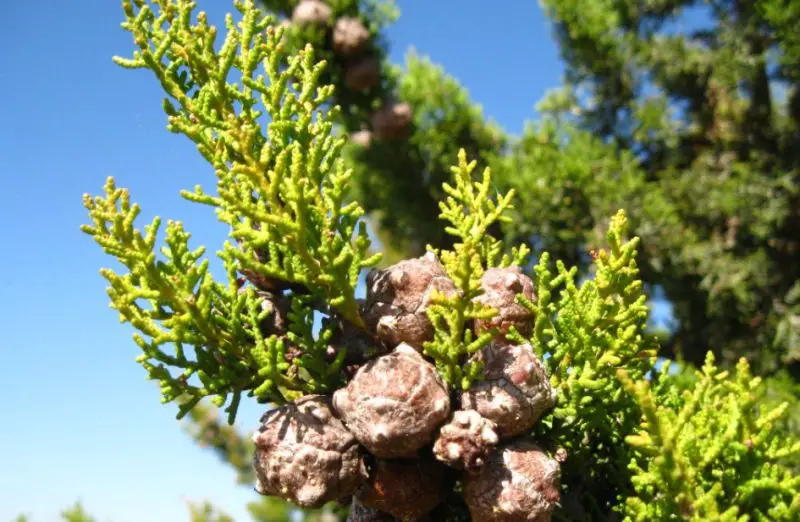
The Tecate cypress (Cupressus forbesii), also known as Forbes cypress, is a distinctive conifer characterized by its upright growth habit. This species typically reaches heights of up to 30 feet with a spread of about 15 feet, making it a manageable size for many landscape applications. One of its most unique features is its multi-trunk growth pattern, which sets it apart from many other cypress varieties.
Adapted to thrive in rocky soils, the Tecate cypress showcases its resilience in challenging environments. Its foliage ranges from deep to light green, complemented by dark brown cones that add visual interest. This cypress is particularly well-suited for drought-tolerant landscapes, making it an excellent choice for water-wise gardening.
The Tecate cypress’s compact size and adaptability make it ideal for hedging, especially in sloped yards where its root system can help stabilize the soil.
Tibetan cypress
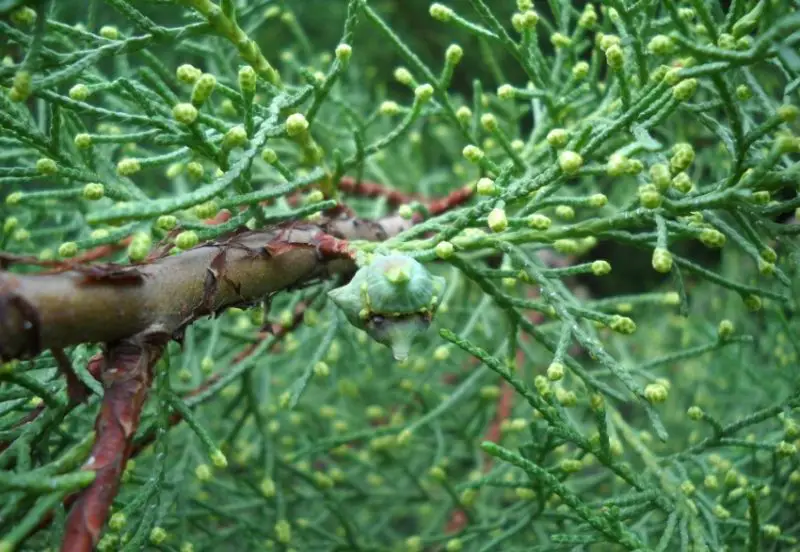
The Tibetan cypress (Cupressus gigantea), also known as Tsangpo cypress, is a majestic conifer considered a subtype of the Himalayan cypress. In its natural habitat, it can reach impressive heights of up to 165 feet, making it a towering presence in the landscape.
This tree is characterized by its striking pyramid form, which adds a dramatic architectural element to its surroundings. The foliage of the Tibetan cypress is equally impressive, featuring a combination of dark green sprays and lighter green needles. This contrast in foliage color creates a rich, textured appearance that enhances its overall visual appeal.

